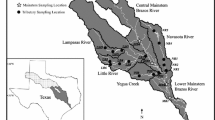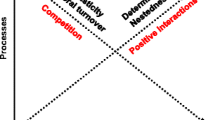Abstract
The regulation of bacterial community biomass and productivity by resources and predators is a central concern in the study of microbial food webs. Resource or bottom-up regulation refers to the limitation of bacteria by carbon and nutrients derived from allocthonous inputs, primary production, and heterotrophic production. Predatory or top-down regulation refers to the limitation of bacteria below levels supportable by resources alone. Large scale comparative studies demonstrate strong correlations between bacterial productivity and biomass, suggesting significant resource regulation. Comparisons of the abundances of heterotrophic flagellates and bacteria, however, imply that in some cases there may be top-down regulation of bacteria in eutrophic environments. Experimental studies in lakes support the importance of resource regulation and reveal little top-down control from protozoans. Increases in bacterial abundance and production with nutrient enrichment were limited in enclosure experiments with high abundances of the cladoceran, Daphnia. Regulation of bacteria by Daphnia may occur in many lakes seasonally and prevail in some lakes throughout the year where these animals sustain dense populations. In most situations, however, bacteria appear to be limited primarily by resources.
Similar content being viewed by others
References
Alldredge AL, Madin LP (1982) Pelagic tunicates: unique herbivores in the marine plankton. Bioscience 32:655–663
Beringer U-G, Finlay BJ, Kuoppo-Leinikki P (1991) Protozoan control of bacterial abundances in fresh water. Limnol Oceanogr 36:139–147
Billen G, Servais P, Becquevort S (1990) Dynamics of bacterioplankton in oligotrophic and eutrophic aquatic environments: bottom-up or top-down control? Hydrobiologia 207:37–42
Bird DF, Kalff J (1984) Empirical relationships between bacterial abundance and chlorophyll concentration in fresh and marine waters. Can J Fish Aquat Sci 41:1015–1023
Caron DA (1991) Evolving role of protozoa in aquatic nutrient cycles. In: Reid PC (ed) Protozoa and their role in marine processes. Springer-Verlag, Berlin, Heidelberg, pp 387–415
Carpenter SR, Kitchell JF (eds) 1993 The trophic cascade in lakes. Cambridge University Press, New York, p 385
Carpenter SR, Kitchell JF, Hodgson JR (1985) Cascading trophic interactions and lake productivity. Bioscience 35:634–639
Cho BC, Azam F (1990) Biogeochemical significance of bacterial biomass in the ocean's euphotic zone. Mar Ecol Prog Ser 63:253–259
Cole JJ, Caraco NF (1993) The pelagic microbial food web of oligotrophic lakes. In: Ford TE (ed) Aquatic microbiology: an ecological approach. Blackwell Scientific Publications, Boston, pp 101–111
Cole JJ, Findlay S, Pace ML (1988) Bacterial production in fresh and saltwater: a cross-system overview. Mar Ecol Prog Ser 43:1–10
Cole JJ, Findlay SEG, Lovett GM (1991) Comparative analyses of ecosystems: patterns, mechanisms, theories. Springer-Verlag, New York, p 375
Crocker KM, Alldredge AL, Steinberg DK (1991) Feeding rates of the doliolid Dolioletta gegenbauri on diatoms and bacteria. J Plankton Res 13:77–82
Currie D (1990) Large-scale variability and interaction among phytoplankton, bacterioplankton, and phosphorus. Limnol Oceanogr 35:1437–1455
Ducklow HW (1992) Factors regulating bottom-up control of bacterial biomass in open ocean communities. Arch Hydrobiol Beih 37:207–217
Ducklow HW, Purdie DA, Williams PJLeB, Davies JM (1986) Bacterioplankton: a sink for carbon in a coastal marine plankton community. Science 232:865–867
Fasham MJR, Ducklow HW, McKelvie SM (1990) A nitrogen-based model of plankton dynamics in the oceanic mixed layer. J Mar Res 48:591–639
Fenchel T (1986) The ecology of heterotrophic microflagellates. Adv Microb Ecol 9:57–97 sup. 5
Fuhrman JA, Suttle CA (1993) Viruses in marine planktonic systems. Oceanography 6:51–63
Gasol JM, Vaqué D (1993) Lack of coupling between heterotrophic nanoflagellates and bacteria: a general phenomenon across aquatic systems? Limnol Oceanogr 38:657–665
Kankaala P (1988) The relative importance of algae and bacteria as food for Daphnia longispina (Cladocera) in a polyhumic lake. Freshwater Biol 19:285–296
King KR, Hollibaugh JT, Azam F (1980) Predator-prey interactions between the larvacean Oikopleura dioica and bacterioplankton in enclosed water columns. Mar Biol 56:49–57
Lee S, Fuhrman JA (1987) Relationships between biovolume and biomass of naturally derived marine bacterioplankton. Appl Environ Microbiol 53:1298–1303
Likens GE (1985) An experimental approach for the study of ecosystems. J Ecol 73:381–396
McManus GB, Fuhrman JA (1988) Control of marine bacterioplankton populations: measurement and significance of grazing. Hydrobiologia 159:51–62
McQueen DJ, Post DJ, Mills RJ (1986) Trophic relationships in freshwater pelagic ecosystems. Can J Fish Aquat Sci 43:1571–1581
McQueen DJ, Mills EL, Forney JL, Johannes MRS, Post JR (1992) Trophic level relationships in pelagic food webs: comparisons derived from long term data sets for Oneida Lake, New York (USA), and Lake St. George, Ontario (Canada). Can J Fish Aquat Sci 49:1588–1596
Menge BA (1992) Community regulation: under what conditions are bottom-up factors important on rocky shores? Ecology 73:755–765
Pace ML (1986) An empirical analysis of zooplankton community size structure across lake trophic gradients. Limnol Oceanogr 31:45–55
Pace ML (1991) Comparative and experimental approaches to the study of microbial food webs. J Protozool 38:87–92
Pace ML (1993) Heterotrophic microbial processes. In: Carpenter SR, Kitchell JF (eds) The trophic cascade in lakes. Cambridge University Press, New York, pp 252–277
Pace ML, Funke E (1991) Regulation of planktonic microbial communities by nutrients and herbivores. Ecology 72:904–914
Pace ML, Vaqué D (in press) The importance of Daphnia in determining mortality rates of protozoans and rotifers in lakes. Limnol Oceanogr
Pace ML, Porter KG, Feig YS (1983) Species- and age-specific differences in bacterial resource utilization by two co-occurring cladocerans. Ecology 64:1145–1156
Pace ML, McManus GB, Findlay SEG (1990) Planktonic community structure determines the fate of bacterial production in a temperate lake. Limnol Oceanogr 35:795–808
Peterson BJ, Hobbie JE, Haney JF (1979) Daphnia grazing on natural bacteria. Limnol Oceanogr 23:1039–1044
Pomeroy LR (1974) The ocean's food web, a changing paradigm. BioScience 24:409–504
Pomeroy LR (1979) Secondary production mechanisms of continental shelf communities. In: Livingston RJ (ed) Ecological processes in coastal marine systems. Plenum Press, New York, pp 163–186
Pomeroy LR, Alberts JJ (1988) Concepts of ecosystem ecology. Springer-Verlag, New York
Pomeroy LR, Wiebe WJ (1988) Energetics of microbial food webs. Hydrobiologia 159:7–18
Pomeroy LR, Wiebe WJ, Deibel D, Thompson RJ, Rowe GT, Pakulski JD (1991) Bacterial responses to temperature and substrate concentrations during the Newfoundland spring bloom. Mar Ecol Prog Ser 75:143–159
Riemann B, Søndergaard M (eds) (1986) Carbon dynamics in eutrophic, temperate lakes. Elsevier, Amsterdam, p 284
Sanders RW, Porter KG, Bennett SJ, DeBiase AE (1989) Seasonal patterns of bacterivory by flagellates, ciliates, rotifers, and cladocerans in a freshwater planktonic community. Limnol Oceanogr 34:673–684
Sanders RW, Caron DA, and Berninger U-G (1992) Relationships between bacteria and heterotrophic nanoplankton in marine and fresh waters: an inter-ecosystem comparison. Mar Ecol Prog Ser 86:1–14
Sherr BF, Sherr EB, Pedrós-Alió C (1989) Simultaneous measurement of bacterioplankton production and protozoan bacterivory in estuarine water. Mar Ecol Prog Ser 54:209–219
Simon M, Cho BC, Azam F (1992) Significance of bacterial biomass in lakes and the ocean: comparison to phytoplankton biomass and biogeochemical implications. Mar Ecol Prog Ser 86:103–110
Stockner JG, Porter KG (1988) Microbial food webs in freshwater planktonic ecosystems. In: Carpenter SR (ed) Complex interactions in lakes ecosystems. Springer-Verlag, New York, pp 69–83
Strayer D, Glitzenstein JS, Jones CJ, Kolasa J, Likens GE, McDonnell MJ, Parker GG, Pickett STA (1986) Long-term ecological studies: an illustrated account of their design, operation, and importance to ecology. (Occasional Publications of the Institute of Ecosystem Studies #2), Institute of Ecosystem Studies, Millbrook, New York
Wiebe WJ, Sheldon WM Jr, Pomeroy LR (1992) Bacterial growth in the cold: evidence for an enhanced substrate requirement. Appl Environ Microbiol 58:359–364
Wikner J, Rassoulzadegan F, Hagstrom A (1990) Periodic bacterivore activity balances bacterial growth in the marine environment. Limnol Oceanogr 35:313–324
Wright RT, Coffin RB, Ersing CP, Pearson D (1982) Field and laboratory measurements of bivalve filtration of natural bacterioplankton. Limnol Oceanogr 27:91–98
Wylie JL, Currie DJ (1991) The relative importance of bacteria and algae as food sources for crustacean zooplankton. Limnol Oceanogr 36:708–728
Author information
Authors and Affiliations
Rights and permissions
About this article
Cite this article
Pace, M.L., Cole, J.J. Comparative and experimental approaches to top-down and bottom-up regulation of bacteria. Microb Ecol 28, 181–193 (1994). https://doi.org/10.1007/BF00166807
Issue Date:
DOI: https://doi.org/10.1007/BF00166807




